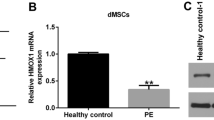Abstract
Preeclampsia (PE) is associated with shallow invasion of the trophoblast and insufficient remodeling of the uterine spiral artery. Glycosylation reactions are catalyzed by glycosyltransferases including N-acetylglucosaminyltransferase V (MGAT5) and accumulating evidence suggests that MGAT5 is correlated with the migration, proliferation, and survival of various cell types. Our previous study confirmed that MGAT5 is a negative regulator of trophoblast migration and invasion via the direct or indirect inhibition of matrix metalloproteinase 2/9 activity. The primary purpose of this study is to investigate the role of MGAT5 in the function of human umbilical vein endothelial cells (HUVECs) during the development of PE. We observed that MGAT5 was specifically localized within the decidual cells and endothelial cells in maternal decidual tissues. The expression of MGAT5 was elevated in PE placentas compared with the normal control placentas. Moreover, the expression of MGAT5 was increased in hypoxia-reoxygenation (H/R)-treated HUVECs. The knockdown of MGAT5 and PD98059 treatment significantly enhanced cell migration in vitro, promoted tube formation capacity, and inhibited apoptosis in H/R-exposed HUVECs. Our data suggest that oxidative stress induces the overexpression of MGAT5 via the regulation of the focal adhesion kinase-extracellular signalregulated kinase signaling pathway, which, in turn, affects the function of endothelial cells, which then participates in the pathogenesis of PE.
Similar content being viewed by others
References
Steegers EA, von Dadelszen P, Duvekot JJ, Pijnenborg R. Pre-eclampsia. Lancet. 2010;376(9741):631–644.
Redman CW, Sargent IL. Latest advances in understanding pre-eclampsia. Science. 2005;308(5728):1592–1594.
Roberts JM, Taylor RN, Musci TJ, Rodgers GM, Hubel CA, McLaughlin MK. Preeclampsia: an endothelial cell disorder. Am J Obstet Gynecol. 1989;161(5):1200–1204.
Sanchez-Aranguren LC, Prada CE, Riano-Medina CE, Lopez M. Endothelial dysfunction and preeclampsia: role of oxidative stress. Front Physiol. 2014;5:372.
Lowe JB, Marth JD. A genetic approach to mammalian glycan function. Annu Rev Biochem. 2003;72:643–691.
Chakraborty AK, Pawelek JM. GnT-V, macrophage and cancer metastasis: a common link. Clin Exp Metastasis. 2003;20(4):365–373.
Gu J, Isaji T, Sato Y, Kariya Y, Fukuda T. Importance of N-glycosylation on alpha5beta1 integrin for its biological functions. Biol Pharm Bull. 2009;32(5):780–785.
Hakomori S. Glycosylation defining cancer malignancy: new wine in an old bottle. Proc Natl Acad Sci U S A. 2002;99(16):10231–10233.
Brockhausen I, Narasimhan S, Schachter H. The biosynthesis of highly branched N-glycans: studies on the sequential pathway and functional role of N-acetylglucosaminyltransferases I, II, III, IV, V and VI. Biochimie. 1988;70(11):1521–1533.
Gu J, Taniguchi N. Regulation of integrin functions by N-glycans. Glycoconj J. 2004;21(1-2):9–15.
Granovsky M, Fata J, Pawling J, Muller WJ, Khokha R, Dennis JW. Suppression of tumor growth and metastasis in Mgat5-deficient mice. Nat Med. 2000;6(3):306–312.
Deng Q, Chen Y, Yin N, et al. N-acetylglucosaminyltransferase V inhibits the invasion of trophoblast cells by attenuating MMP2/9 activity in early human pregnancy. Placenta. 2015;36(11):1291–1299.
Raijmakers MT, Dechend R, Poston L. Oxidative stress and pre-eclampsia: rationale for antioxidant clinical trials. Hypertension. 2004;44(4):374–380.
Hung TH, Skepper JN, Burton GJ. In vitro ischemia-reperfusion injury in term human placenta as a model for oxidative stress in pathological pregnancies. Am J Pathol. 2001;159(3):1031–1043.
Cudmore M, Ahmad S, Al-Ani B, et al. Negative regulation of soluble Flt-1 and soluble endoglin release by heme oxygenase-1. Circulation. 2007;115(13):1789–1797.
Bouchard V, Demers MJ, Thibodeau S, et al. Fak/Src signaling in human intestinal epithelial cell survival and anoikis: differentiation state-specific uncoupling with the PI3-K/Akt-1 and MEK/Erk pathways. J Cell Physiol. 2007;212(3):717–728.
Chung BH, Cho YL, Kim JD, et al. Promotion of direct angiogen-esis in vitro and in vivo by Puerariae flos extract via activation of MEK/ERK-, PI3K/Akt/eNOS-, and Src/FAK-dependent pathways. Phytother Res. 2010;24(6):934–940.
Zhao Y, Li J, Xing Y, et al. N-acetylglucosaminyltransferase V mediates cell migration and invasion of mouse mammary tumor cells 4TO7 via RhoA and Rac1 signaling pathway. Mol Cell Biochem. 2008;309(1-2):199–208.
Yang HM, Yu C, Yang Z. N-acetylglucosaminyltransferase V negatively regulates integrin alpha5beta1-mediated monocyte adhesion and transmigration through vascular endothelium. Int J Oncol. 2012;41(2):589–598.
Sibai BM, Stella CL. Diagnosis and management of atypical preeclampsia-eclampsia. Am J Obstet Gynecol. 2009;200(5):481.
Burton GJ, Sebire NJ, Myatt L, et al. Optimising sample collection for placental research. Placenta. 2014;35(1):9–22.
Yang Z, Bai B, Luo X, et al. Downregulated Krüppel-like factor 8 is involved in decreased trophoblast invasion under hypoxia-reoxygenation conditions. Reprod Sci. 2014;21(1):72–81.
Shan N, Zhang X, Xiao X, et al. Laminin alpha4 (LAMA4) expression promotes trophoblast cell invasion, migration, and angiogenesis, and is lowered in preeclamptic placentas. Placenta. 2015;36(8):809–820.
Gao L, Qi HB, Kamana KC, Zhang XM, Zhang H, Baker PN. Excessive autophagy induces the failure of trophoblast invasion and vasculature: possible relevance to the pathogenesis of pree-clampsia. J Hypertens. 2015;33(1):106–117.
Liu X, Mu H, Luo X, et al. Expression of Gadd45alpha in human early placenta and its role in trophoblast invasion. Placenta. 2014;35(6):370–377.
Luo X, Yao ZW, Qi HB, et al. Gadd45a as an upstream signaling molecule of p38 MAPK triggers oxidative stress-induced sFlt-1 and sEng upregulation in preeclampsia. Cell Tissue Res. 2011;344(3):551–565.
Shan N, Zhang X, Xiao X, et al. The role of laminin a4 in human umbilical vein endothelial cells and pathological mechanism of preeclampsia. Reprod Sci. 2015;22(8):969–979.
Dhar-Mascareno M, Carcamo JM, Golde DW. Hypoxia-reoxygenation-induced mitochondrial damage and apoptosis in human endothelial cells are inhibited by vitamin C. Free Radic Biol Med. 2005;38(10):1311–1122.
Padmini E, Uthra V, Lavanya S. Effect of HSP70 and 90 in modulation of JNK, ERK expression in preeclamptic placental endothelial cell. Cell Biochem Biophys. 2012;64(3):187–195.
Guo HB, Lee I, Kamar M, Akiyama SK, Pierce M. Aberrant N-glycosylation of beta1 integrin causes reduced alpha5beta1 integrin clustering and stimulates cell migration. Cancer Res. 2002;62(23):6837–6845.
Author information
Authors and Affiliations
Rights and permissions
About this article
Cite this article
Deng, Q., Chen, Y., Yin, N. et al. The Role of MGAT5 in Human Umbilical Vein Endothelial Cells: Possible Relevance to the Pathological Mechanism of Preeclampsia. Reprod. Sci. 24, 313–323 (2017). https://doi.org/10.1177/1933719116655602
Published:
Issue Date:
DOI: https://doi.org/10.1177/1933719116655602




